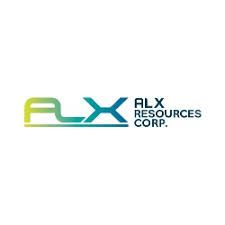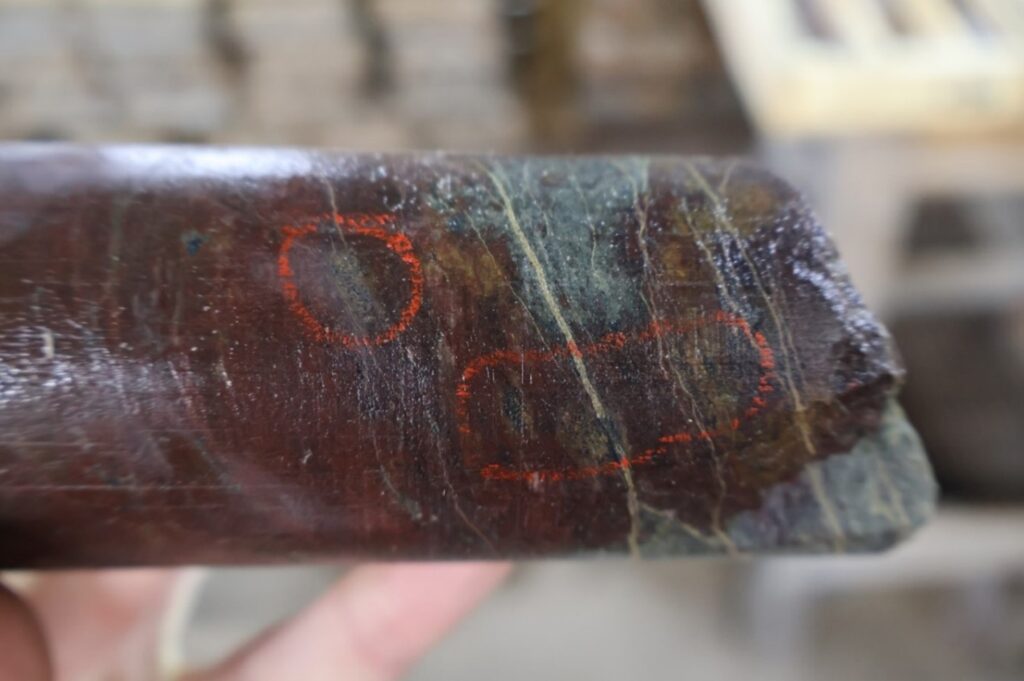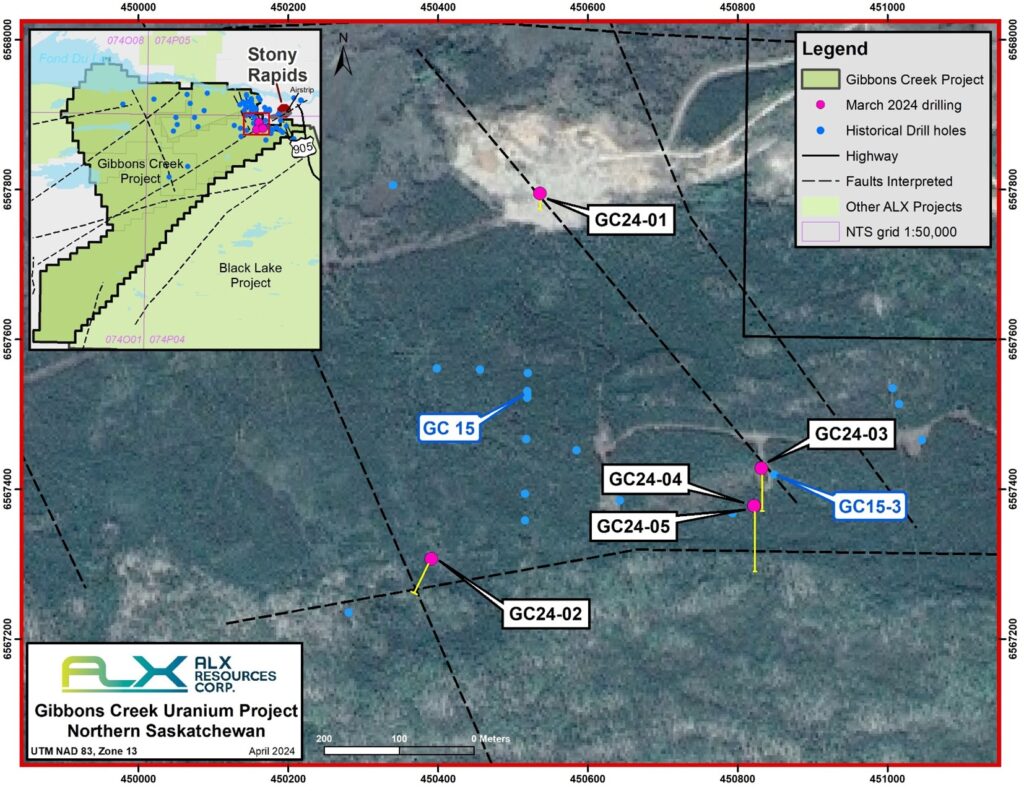
ALX Resources Corp. Receives Analytical Results from the Gibbons Creek Uranium Project, Athabasca Basin, Saskatchewan

ALX Resources Corp. (TSX-V: AL) (FSE: 6LLN) (OTC: ALXEF) is pleased to announce the results of the 2024 winter drilling program and upcoming summer 2024 exploration plans at its Gibbons Creek Uranium Project located in the northern Athabasca Basin near the community of Stony Rapids, Saskatchewan.
Gibbons Creek is the subject of an option earn-in transaction with Trinex Lithium Ltd., a wholly-owned subsidiary of Trinex Minerals Limited which is a publicly-traded mineral exploration company listed on the Australian Securities Exchange. Under the terms of a definitive agreement signed in May 2024, Trinex can earn an initial 51% interest and up to a 75% participating interest in the Project in two stages over a period of five years by making cash payments and common shares payments to ALX, and by incurring exploration expenditures at the Project (see ALX news release dated May 8, 2024).
Highlights of the 2024 Exploration Program
- Assay results and downhole probe readings confirm the presence of anomalous uranium within the Airstrip Prospect at Gibbons Creek;
- A comprehensive helicopter-borne vertical transient electromagnetic survey is planned to commence in June 2024, covering the Airstrip and Butler Lake Prospects and a recently identified new target known as Gibbons East;
- Further drilling is planned following the analysis and interpretation of the VTEM data;
- Trinex is fully-funded to complete the upcoming work programs planned for 2024.
Results of the 2024 Drilling Program
Results from the 2024 winter drilling program have confirmed low-level uranium mineralization in four of the five holes completed having intersected anomalous uranium at or near the unconformity between the Athabasca Sandstone and underlying basement metasediments, which are variably altered. Results from the drilling greater than 100 parts per million (“ppm”) U3O8 are shown in Table 1.
Table 1 – Assay Results from 2024 Drill Program
| Hole ID | Sample ID |
From (m) |
To (m) |
Interval (m) |
U3O8P (ppm) |
U3O8T (ppm) |
| GC24-02 | 422023 | 108.92 | 109.42 | 0.5 | 325 | 384 |
| GC24-03 | 422178 | 109.34 | 109.84 | 0.5 | 156 | 186 |
| GC24-03 | 422179 | 109.84 | 110.34 | 0.5 | 259 | 382 |
| GC24-03 | 422181 | 110.34 | 110.84 | 0.5 | 147 | 203 |
| GC24-04 | 422083 | 107.18 | 107.54 | 0.36 | 157 | 208 |
| GC24-04 | 422218 | 107.54 | 107.98 | 0.44 | 641 | 757 |
| GC24-05 | 422278 | 103.06 | 103.56 | 0.5 | 134 | 198 |
(P: uranium results by partial digestion; T: uranium results by total digestion)
The geochemical uranium assay results (expressed in ppm U3O8) were obtained using a standard sampling interval of 0.5 metres; smaller intervals may be used such that individual samples do not cross lithological contacts or unit boundaries. These sampling intervals are suitable for uranium mineralization such as the blebby and sporadic mineralization intersected in drill hole GC24-04 (Fig. 1). Gamma probe radiometric readings (expressed in cps) are obtained from a different (i.e., larger) volume of rock than assay samples and hand-held scintillometer cps readings, and typically give larger relative values compared to hand-held scintillometer readings.

Fig. 1: Close-up of uranium mineralization in core sample from GC24-04 – peak radioactivity (8,662 cps) at 107.87 m
Gibbons Creek Winter Drilling Program Summary
The 2024 winter drilling program at Gibbons Creek was designed to test for continuity of uranium mineralization first discovered in 1979 by Eldorado Nuclear (“Eldorado”). ALX defined a target area for the drill program in late 2023 by carrying out a high-resolution magnetic survey and a Soil Gas Hydrocarbon (“SGH”) survey.
Drilling intersected uranium mineralization in two areas located 500 metres apart within this target area.
Hole GC24-01 was drilled to target a historical radon anomaly and completed at 159.0 metres. Basement rocks were intersected from 146.0 metres to end of hole at 159.0 metres. The basement rocks are fresh and unfractured pelitic to semi-pelitic metasediments that are locally garnetiferous. No significant radioactivity was identified in the hole.
Hole GC24-02 was drilled at the intersection of east-west and north-northwest faults interpreted from the 2023 ground magnetic survey and intersected fracture-controlled and disseminated blebs of uranium mineralization at 0.8 metres below the unconformity, which was reached at a depth of 108.4 metres.
An Exploranium GR-135 handheld scintillometer measured radioactivity of 220 counts per second and a Mount Sopris 2PGA-1000 downhole gamma probe1 measured a radiometric peak of 3,321 cps within a 0.6 metre interval of anomalous radioactivity from 108.9 to 109.5 metres. Drill hole GC24-02 represents an approximately 470-metre step-out to the west of ALX’s historical hole GC15-03 (0.143% U3O8 assay over 0.23 metres) and was collared approximately 350 metres to the southwest of Eldorado’s 1979 hole GC-15 (1,520 ppm uranium over 0.13 metres) (see Fig. 2).

Fig. 2: Gibbons Creek 2024 Drilling Plan
Hole GC24-03 was drilled as a 25-metre westward step out of unconformity-related uranium mineralization in historical hole GC15-03 to test the continuity of an interpreted trend of anomalous uranium mineralization between GC15-03 and historical drill hole GC-15, which are 340 metres apart. Anomalous radioactivity and fracture-controlled uranium mineralization was intersected from 110.0 to 110.9 metres approximately 1.5 metres below the unconformity at 108.5 metres.
The Exploranium GR-135 handheld scintillometer measured a peak radioactivity value of 190 cps and the Mount Sopris 2PGA-1000 downhole gamma probe measured a radiometric peak of 2,217 cps within the noted anomalous radioactive interval. Uranium mineralization was observed as coatings on fractures in the drill core at 110.2 metres as well as other fractures between 110.0 and 110.9 metres.
Hole GC24-04 exhibited the strongest radiometric response of the program to date where uranium mineralization was intersected over 1.1 metres from 107.17 to 108.27 metres beginning immediately at and below the unconformity at 107.18 metres.
The Athabasca formation sandstone immediately above the mineralization was strongly bleached from an unaltered dusky maroon colour to white, indicative of hydrothermal activity in the location of the drill hole.
A Mount Sopris 2PGA-1000 downhole gamma probe measured a radioactive peak of 8,662 cps within the mineralized interval (Fig. 1), which shows black blebs of uranium mineralization (likely pitchblende) within dark red hematite alteration and closely associated with lesser amounts of yellow limonite alteration.
The blebs of uranium mineralization appear to follow both the foliation of the rock and to spread along some of the fine fractures. Zones of strong fracturing and fault breccias, variably strongly hematitic (paleoweathered), argillized or chloritized, were intermittently encountered down to approximately 142.0 metres.
Hole GC24-05 was drilled from the same setup as GC24-04 by tilting the drill head following an in-field interpretation of a possible fault offset of the unconformity. Fine-grained blebs of black uranium mineralization were observed between approximately 103.4 to 103.5 metres. Several of the blebs have bleached haloes and others appear within or adjacent to weak limonitic alteration haloes. Dark grey quartz grains in the vicinity of the uranium mineralization may represent a metamict alteration of the quartz structure due to the radioactivity.
Summer 2024 Drilling Program
Further drilling at the Project is planned for the summer of 2024 to search for fault offsets in the area of GC24-04, which can act as structural traps for the deposition of uranium mineralization. The interpreted extension of the southwest-trending structure that appears to be associated with mineralization at the Airstrip Prospect extends through to the Butler Lake Target, increasing the prospectivity of the area.
About Gibbons Creek
Gibbons Creek consists of eight mineral claims comprising 13,864 hectares (34,258 acres) located along the northern margin of the Athabasca Basin.
The Project is located in a region that hosts numerous historical uranium occurrences, such as the Black Lake discoveries in several drill holes beginning in 2004, and the historical Nisto Mine, from which 500 tons of ore was shipped in 1950 to the historical Lorado Mill at Uranium City, SK, including 106 tons grading 1.6% U3O8 (Source: Saskatchewan Mineral Deposits Index, #1621). ALX holds an exploration permit for Gibbons Creek, good until October 2025, which allows for up to 20 diamond drill holes totaling approximately 5,000 metres, along with ground-based geophysics, prospecting, and geochemical sampling. Access to Gibbons Creek is via roads and trails that lead from the community of Stony Rapids, SK, which is connected to all-weather Highway 905, thereby creating flexibility for either summer or winter exploration programs. Stony Rapids has readily-available fuel, supplies and accommodations for field personnel, and an airport with daily flights to cities and towns in southern Saskatchewan.
Prior to commencement of the 2024 drilling program, ALX carried out a comprehensive review of Gibbons Creek historical exploration data and has integrated that information with the high-resolution magnetic and SGH geochemical surveys completed in November 2023. The historical data and the results of ALX’s ground surveys on the 2023 exploration grid show important characteristics of the Project’s potential to host uranium mineralization, which is demonstrated by the mineralization found in ALX’s 2015 hole GC15-03 (0.13% U3O8 over 0.23 metres from 107.67 metres to 107.90 metres), in Eldorado’s 1979 hole GC-15 (0.179% U3O8 over 0.13 metres from 134.11 to 134.24 metres), and in the holes drilled in the 2024 program.
For additional information on Gibbons Creek, please visit the ALX website: click here
National Instrument 43-101 Disclosure and Statement of Qualified Person
Geochemical analyses on samples from ALX’s 2015 drill hole described in this news release were carried out by Activation Laboratories in Ancaster, Ontario using Inductively-Coupled Plasma Mass Spectrometry (“ICP-MS”) methods on both partial and total digestions. Eldorado’s 1979 geochemical analyses were carried out by Bondar-Clegg & Company Ltd. Laboratories, Ottawa, Ontario using Atomic Absorption, Colormetric, Fluorometric and XRF methods, which were standard methods of that exploration era.
All drill core samples from the 2024 program were shipped to SRC Geoanalytical Laboratories in Saskatoon, SK, an ISO/IEC 17025/2005 and Standards Council of Canada certified analytical laboratory. ALX requests multi-element analysis by ICP-MS and ICP-OES using total (HF:NHO3:HClO4) and partial digestion (HNO3:HCl), boron by fusion, and U3O8 wt% assay by ICP-OES where applicable. One half of the split core samples are retained and the other half cores are sent to the SRC for analyses. Blanks, standard reference materials, and repeats are inserted into the sample stream at regular intervals by ALX and SRC in accordance with industry-standard quality assurance/quality control (“QA/QC”) procedures. Uranium assay samples may be conducted on samples that return greater than 500 ppm uranium in the initial ICP analyses.
All reported depths and intervals are drill hole depths and intervals, unless otherwise noted, and do not represent true thicknesses, which have yet to be determined. Readers are cautioned that scintillometer and gamma probe measurements of drill core are not directly indicative of uranium grades in the sample measured and should be considered only as a preliminary indication of the presence of radioactive materials.
The technical information in this news release has been reviewed and approved by Robert Campbell, P.Geo., who is a Qualified Person in accordance with the Canadian regulatory requirements set out in National Instrument 43-101.
About ALX
ALX is based in Vancouver, BC, Canada and its common shares are listed on the TSX Venture Exchange under the symbol “AL”, on the Frankfurt Stock Exchange under the symbol “6LLN” and in the United States OTC market under the symbol “ALXEF”.
ALX’s mandate is to provide shareholders with multiple opportunities for discovery by exploring a portfolio of prospective mineral properties in Canada, which include uranium, lithium, nickel-copper-cobalt and gold projects. The Company uses the latest exploration technologies and holds interests in over 240,000 hectares of prospective lands in Saskatchewan, a stable jurisdiction that hosts the highest-grade uranium mines in the world, a producing gold mine, diamond deposits, and historical production from base metals mines.
ALX’s uranium holdings in northern Saskatchewan include 100% interests in the Gibbons Creek Uranium Project (now the subject of an option earn-in agreement with Trinex Minerals Limited), the Sabre Uranium Project, the Bradley Uranium Project, and the Javelin and McKenzie Lake Uranium Projects, a 40% interest in the Black Lake Uranium Project (a joint venture with Uranium Energy Corporation and Orano Canada Inc.), and a 20% interest in the Hook-Carter Uranium Project, located within the uranium-rich Patterson Lake Corridor with Denison Mines Corp. (80% interest) as operator of exploration since 2016.
ALX also owns 100% interests in the Firebird Nickel Project, the Flying Vee Nickel/Gold and Sceptre Gold projects, and can earn up to an 80% interest in the Alligator Lake Gold Project, all located in northern Saskatchewan, Canada. ALX owns, or can earn, up to 100% interests in the Electra Nickel Project and the Cannon Copper Project located in historic mining districts of Ontario, Canada, and in the Vixen Gold Project (now under option to First Mining Gold Corp., who can earn up to a 100% interest in two stages).
ALX owns a 50% interest in eight lithium exploration properties staked in 2022-2023 collectively known as the Hydra Lithium Project, located in the James Bay region of northern Quebec, Canada, a 100% interest in the Anchor Lithium Project in Nova Scotia, Canada, and 100% interests in the Crystal Lithium Project and the Reindeer Lithium Project, both located in northern Saskatchewan, Canada.
MORE or "UNCATEGORIZED"
Kuya Silver Confirms High-Grade Silver-Gold Vein Mineralization at Umm-Hadid with Initial Drill Results up to 1483.9 g/t AgEq over 2 Metres
Kuya Silver Corporation (CSE: KUYA) (OTCQB: KUYAF) (FSE: 6MR1) is... READ MORE
First Phosphate Closes Final Tranche of Oversubscribed Private Placement
First Phosphate Corp. (CSE: PHOS) (OTCQX: FRSPF) (FSE: KD0) is... READ MORE
GFG Receives Final Payment from the Sale of its Rattlesnake Hills Gold Project
GFG Resources Inc. (TSX-V: GFG) (OTCQB: GFGSF) announces that i... READ MORE
Goliath Receives $1,730,882 Through Warrant Exercises, Inclusive Of Crescat Capital A Longtime Strategic And Cornerstone Shareholder
Goliath Resources Limited (TSX-V: GOT) (OTCQB: GOTRF) (FSE: B4IF)... READ MORE
Robex Pours First Gold at Kiniéro on Schedule and Budget
Highlights: Gold bar weighing 2.64 kilograms (85 oz) poured in th... READ MORE












